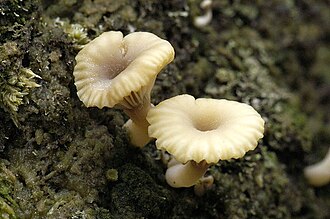Basidiolichen


Basidiolichen is a type of lichen that forms a symbiotic relationship between a basidiomycete fungus and one or more photosynthetic partners, usually green algae or cyanobacteria. This relationship is distinct from the more commonly known ascolichens, which involve ascomycete fungi. Basidiolichens are less common and represent a unique adaptation to their environment, showcasing the diversity of life forms and symbiotic relationships in nature.
Characteristics[edit]
Basidiolichens are characterized by their basidiomycete fungal component. Unlike ascolichens, where the fungal partner produces spores in sac-like structures called asci, basidiolichens produce spores on the surface of basidia. The structure of a basidiolichen typically includes a mycobiont (the fungal partner) and a photobiont (the photosynthetic partner), which work together to survive in various environments, often harsh ones where neither could survive alone.
The morphology of basidiolichens can vary significantly, but they often form crust-like or leafy structures on the surfaces they inhabit, such as rocks, soil, or the bark of trees. The color, shape, and size of these lichens can vary widely, depending on the species and environmental conditions.
Ecology[edit]
Basidiolichens are found in a variety of ecosystems around the world, from tropical forests to arctic tundras. They play an essential role in their ecosystems, including soil formation, nutrient cycling, and serving as a food source for various animals. They are also indicators of environmental health, as they are sensitive to air pollution and changes in their habitats.
Reproduction[edit]
Reproduction in basidiolichens can occur both sexually and asexually. Sexual reproduction involves the production of spores by the basidiomycete partner, which then need to find a compatible photobiont to establish a new lichen. Asexual reproduction can occur through the dispersal of parts of the lichen that contain both the mycobiont and photobiont, allowing them to grow into a new organism without the need for spore production.
Classification[edit]
The classification of basidiolichens is primarily based on the fungal partner, as the basidiomycete fungi are the defining characteristic of these lichens. However, the taxonomy is complex and subject to change as new information becomes available through molecular and genetic studies. Basidiolichens belong to various orders within the Basidiomycota phylum, with each order containing species that have adapted to form lichenized relationships with photosynthetic partners.
Conservation[edit]
Like many lichens, basidiolichens are threatened by habitat destruction, pollution, and climate change. Conservation efforts are essential to protect these unique organisms and the roles they play in their ecosystems. Understanding the biology, ecology, and distribution of basidiolichens is crucial for developing effective conservation strategies.

Ad. Transform your life with W8MD's Budget GLP-1 injections from $75


W8MD offers a medical weight loss program to lose weight in Philadelphia. Our physician-supervised medical weight loss provides:
- Weight loss injections in NYC (generic and brand names):
- Zepbound / Mounjaro, Wegovy / Ozempic, Saxenda
- Most insurances accepted or discounted self-pay rates. We will obtain insurance prior authorizations if needed.
- Generic GLP1 weight loss injections from $75 for the starting dose.
- Also offer prescription weight loss medications including Phentermine, Qsymia, Diethylpropion, Contrave etc.
NYC weight loss doctor appointmentsNYC weight loss doctor appointments
Start your NYC weight loss journey today at our NYC medical weight loss and Philadelphia medical weight loss clinics.
- Call 718-946-5500 to lose weight in NYC or for medical weight loss in Philadelphia 215-676-2334.
- Tags:NYC medical weight loss, Philadelphia lose weight Zepbound NYC, Budget GLP1 weight loss injections, Wegovy Philadelphia, Wegovy NYC, Philadelphia medical weight loss, Brookly weight loss and Wegovy NYC
|
WikiMD's Wellness Encyclopedia |
| Let Food Be Thy Medicine Medicine Thy Food - Hippocrates |
Medical Disclaimer: WikiMD is not a substitute for professional medical advice. The information on WikiMD is provided as an information resource only, may be incorrect, outdated or misleading, and is not to be used or relied on for any diagnostic or treatment purposes. Please consult your health care provider before making any healthcare decisions or for guidance about a specific medical condition. WikiMD expressly disclaims responsibility, and shall have no liability, for any damages, loss, injury, or liability whatsoever suffered as a result of your reliance on the information contained in this site. By visiting this site you agree to the foregoing terms and conditions, which may from time to time be changed or supplemented by WikiMD. If you do not agree to the foregoing terms and conditions, you should not enter or use this site. See full disclaimer.
Credits:Most images are courtesy of Wikimedia commons, and templates, categories Wikipedia, licensed under CC BY SA or similar.
Translate this page: - East Asian
中文,
日本,
한국어,
South Asian
हिन्दी,
தமிழ்,
తెలుగు,
Urdu,
ಕನ್ನಡ,
Southeast Asian
Indonesian,
Vietnamese,
Thai,
မြန်မာဘာသာ,
বাংলা
European
español,
Deutsch,
français,
Greek,
português do Brasil,
polski,
română,
русский,
Nederlands,
norsk,
svenska,
suomi,
Italian
Middle Eastern & African
عربى,
Turkish,
Persian,
Hebrew,
Afrikaans,
isiZulu,
Kiswahili,
Other
Bulgarian,
Hungarian,
Czech,
Swedish,
മലയാളം,
मराठी,
ਪੰਜਾਬੀ,
ગુજરાતી,
Portuguese,
Ukrainian